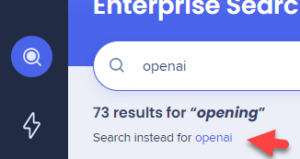Welcome to the
WalkMe Help Center
Please log in to continue

Please log in to continue

The WalkMe Menu Enterprise Search empowers you to discover applications and resources through a comprehensive, unified search experience. It functions as a robust search engine capable of searching for information across both WalkMe content and content within third-party apps that were added through the Console's Integrations page.
Enterprise search does the following:
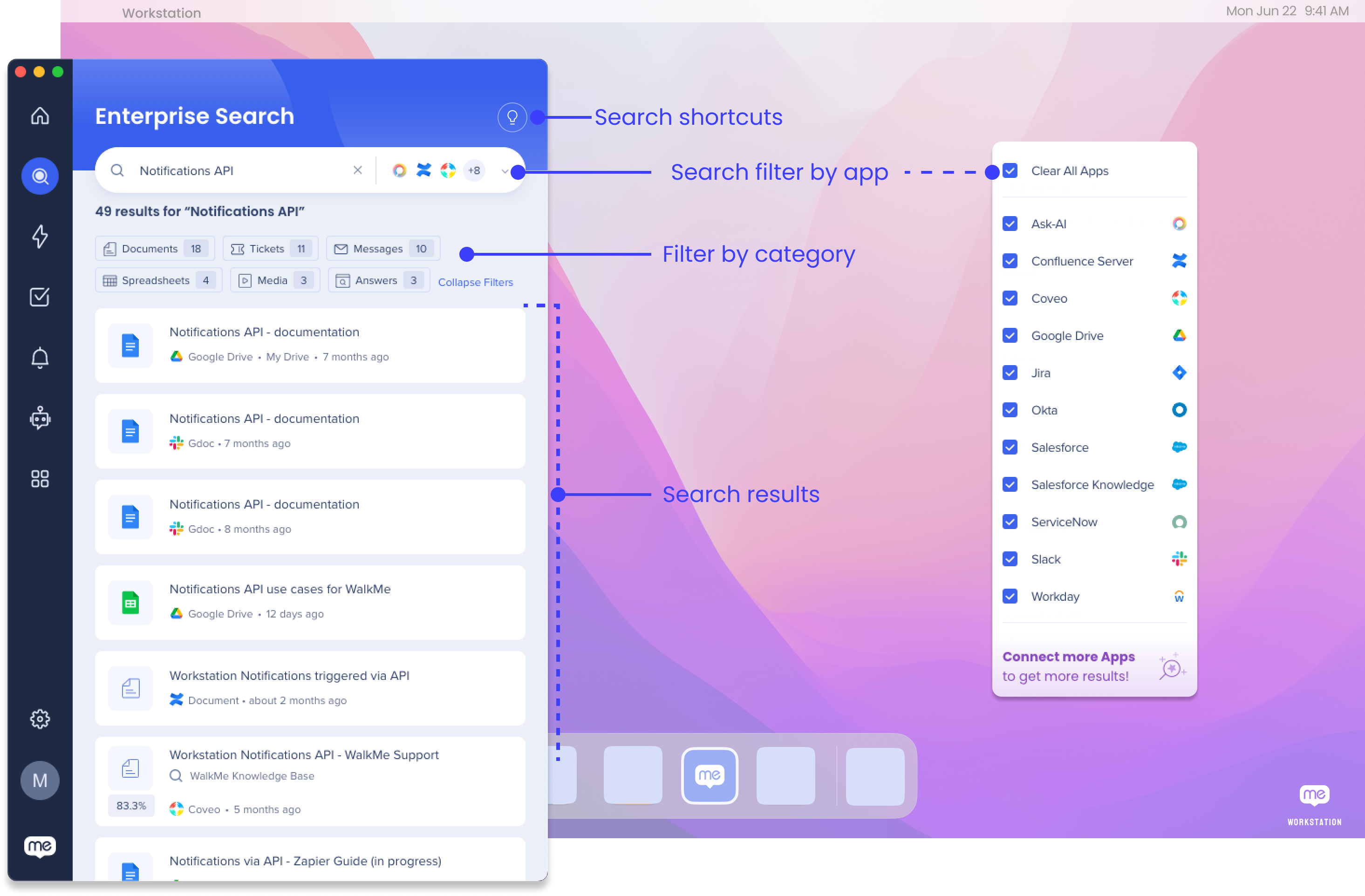
You can search across all of your integrated apps, or filter the search to specific apps:
There are also quick keyboard shortcuts you can use in order to adjust your apps without changing the search filter.

When your search results load, there are additional category filters that appear. This lets you further specify your search to the content type.
This comes in handy, for example, if you know you're looking for a document, but you don't remember what app it's from. Simply click the Document button and the search will filter to only documents across all of the apps in your search filter.
The category filter only shows the content type that appeared in the search results. So if none of the results are a document, then the document category won't be a choice.

Your search results will show you the content name and what app it's from. Clicking on a result will put it in the Recently Viewed widget on your homepage so that you can quickly get back to it.
Enterprise Search supports all languages. This means you can search using your preferred language, making it easier and faster to find the information you need.
Users no longer need to worry about precise spelling or exact matches. Our search capability will intelligently understand their intent and provide the most relevant results, even if there are minor errors or misspellings in the search query.
Here's how it works:
The Enterprise Search uses a Sorter Service that sorts the results according to its relevance. How the sorter service performs the sorting:
A user searches for a term in the desktop/mobile menu app
Search service gets the term and calls for each connected app's service in real time
Connected app's service search for this term, each with its own API call and implementation
Search service gets all the search results from all the connected apps
Search service calls the sorter service with the results
Sorter service sorts/orders the results and sends the sorted/ordered results back to the Search service
Search service returns the results back to the desktop/mobile menu app
The Sorter service uses 9 different scoring methods, including stemming, fuzziness and NLP, in addition to the basic Levenshtein distance. Each results gets gets 9 scores (one per method), ranging from 0 to 1, in order to set the prioritization.
LevenshteinFast: Computational algorithm used to calculate the Levenshtein distance between two strings, which is a measure of the minimum number of single-character edits (insertions, deletions or substitutions) required to transform one string into the other
JaroWinkler: String similarity measure that is used to compare the similarity between two strings
IdenticalTokens: Grants a score based on relative number of identical words (tokens)
IdenticalTokensStemmed: Grants a score based on relative number of identical stemmed words (tokens) - stemming is the process of removing ing, ed etc. from a word in order to get its most basic form
Stopwords: Grants a score based on the relative number of identical words (tokens) while ignoring stop words (if, and, or etc.)
Fuzzy: Grants a score for similarity of 2 strings while taking typos into consideration
RequestKind: Describes the type or category of a request made by a user (Currently not in use)
TimeRelevancyStart: a function that scores search results based on their recency, giving a higher score to more recently edited/created documents. It grants a score according to the time difference (days) between now and the result's last edit/create date. This function only works if the app's API supports it, like in Google Drive
TFIDF (Term Frequency-Inverse Document Frequency): It is a numerical statistic that reflects how important a word is to a document in a collection or corpus. It calculates a score based on the frequency of the word in the document and the rarity of the word in the entire collection. This method is only used and effective when searching for phrases with more than two words
The sorter in the desktop/mobile menu gives priority to the following results in the search:
Recently Viewed: Items that were recently viewed by the user get a higher prioritization in search results, since they're most likely to be more relevant to the user during the search process
Apps (from IDP integrations like Okta): When there is a 100% match between the search query and an app result, it will receive higher priority
Native sorting: Results from the following applications give prioritization to the order of results received from API's and leverages the 3rd parties prioritization capabilities to display similar order to native applications
Confluence
Jira
Resources: In cases where there are results containing both WalkMe content and integrations, and no results have a 100% match, the resources results will be prioritized. Two resources are displayed on top of the search results
Our entry algorithm generates entries for each WalkMe item based on their title and keywords.
If an item has no keywords, only one entry is created using its title
If an item has keywords, additional entries are generated for each keyword including the title and the keyword itself
Each entry is scored based on its relevance to the search query, and the results are displayed accordingly. To increase the chances of an item appearing in search results, it's important to have keywords that closely match the search terms. However, keywords are not considered word-by-word, but as a whole. Therefore, long keywords should be split into logical groups or terms.
For example, "career development learning training advice information help system" would be better split as "career development", "learning system", "training system"
Note that an exact match is not required. For instance, an item with the keyword music could still appear in search results for the term musician
Separating each possible word as a keyword can harm the search results.
For instance, the keyword “career development learning training advice information help system" will match with terms like "legal advice", "onboarding system", "vacation help", and so on, if each word is considered as a separate keyword. Therefore, it's better to be more precise as mentioned above to reduce false positives while still making it useful for partial searches

The desktop/mobile menu does not index results. Some data is stored on the client side. For example, the data which appears on Recent Search Results or in the Recently Viewed widget.
Rest of the data displayed to the user on the Search flow is brought in real-time from the 3rd-party apps API's.
The Enterprise Search uses 3rd-party integrations to implement a “federal search”. Searches within the desktop/mobile menu are backed by an NLP engine, and a graph database that supports a great user experience. The Enterprise Search doesn't index 3rd-party data on an independently searchable database. See below sequence diagram describes the searching algorithm:
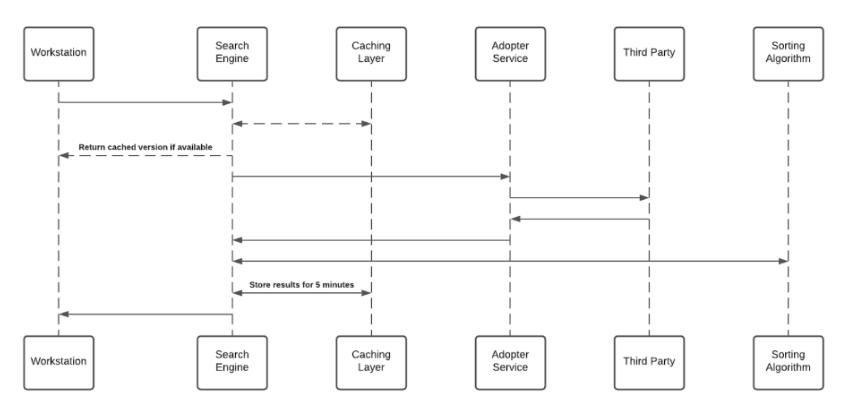
To activate the Enterprise Search (and the Personalized Workspace widgets), each employee is required to grant the desktop/mobile menu permission to access the 3rd-party. The granting process is using the OAuth2.0 protocol. Each time a new access token is granted to the desktop/mobile menu, the application will encrypt the access and refresh tokens and store it in a remote database.
The encryption process includes a unique private key (“salt”) that is generated for each individual at the very first bootstrap and stored in the local machine Keychain. The salt is irreplaceable and not restorable – losing it causes the access tokens to be voided. This security measure is being taken to eliminate identity spoofing when accessing high-sensitive data.
See the diagram below to review the salt generation and storage flow.
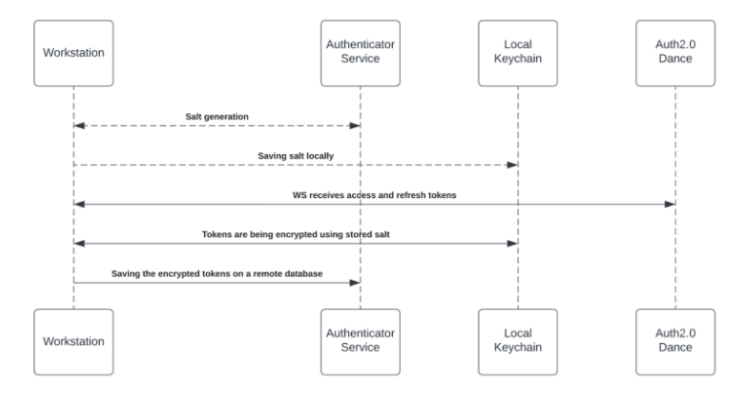
Accessing 3rd-party content requires user consent, and in some cases, mostly on Microsoft products, an organization admin consent. Users grant the desktop/mobile menu the necessary permission by approving an OAuth2.0 consent screen that is being triggered by them from the desktop/mobile menu application (“Third-party apps”).
The third-party apps are being approved and verified by third-parties products. By the end of the granting process, the third-party apps provide access and refresh tokens that are used by the search engine to establish the requests.
See 3rd-Party Access and Refresh Tokens section above for more information about the storing mechanism.
While searching, the search engine forwards the request, before hitting the Adopter Service, through the Token Injector; a service that injects the relevant tokens to accomplish the request. The local private key is being handed off over the search HTTPS request for runtime decryption.
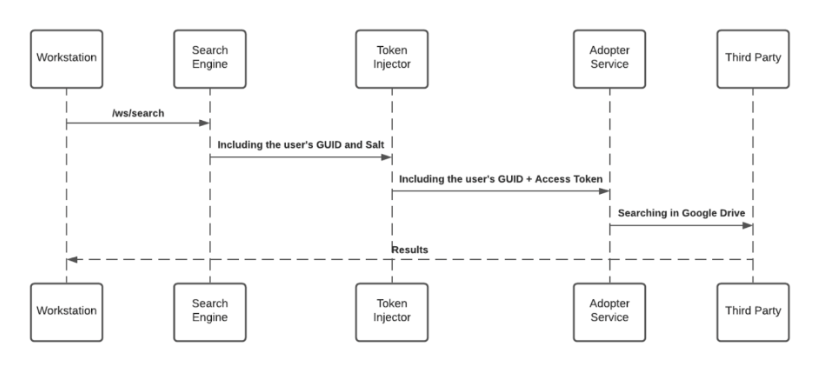
When a user initiates a search query – the WalkMe enterprise search starts a search flow that is being protected by a JWT assigned by WalkMe IdP integration, as part of the user signing flow:
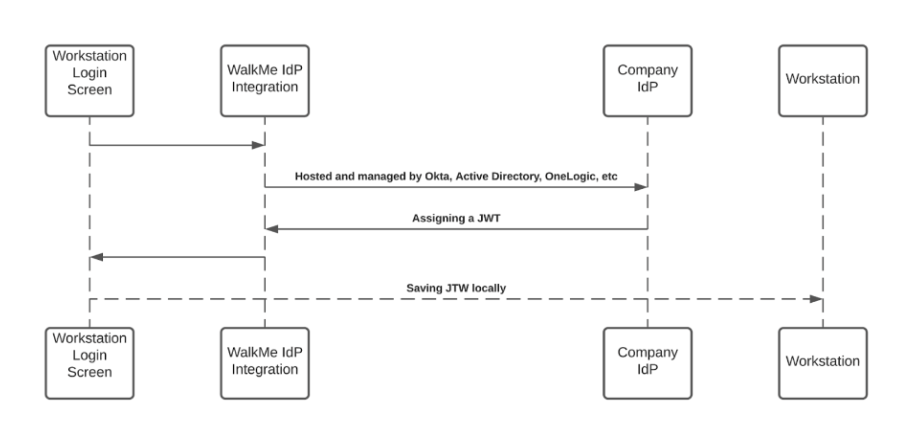
The JWT is proxying the user identity and keeping any HTTPS request secured and individual.
All the desktop/mobile menu requests are protected by a JWT validation.
Read more about integration security here.
Fuzzy Search provides an auto-correction to search queries. The search intelligently understands users' intent and delivers relevant results, even if there are minor errors or misspellings in the search queries.
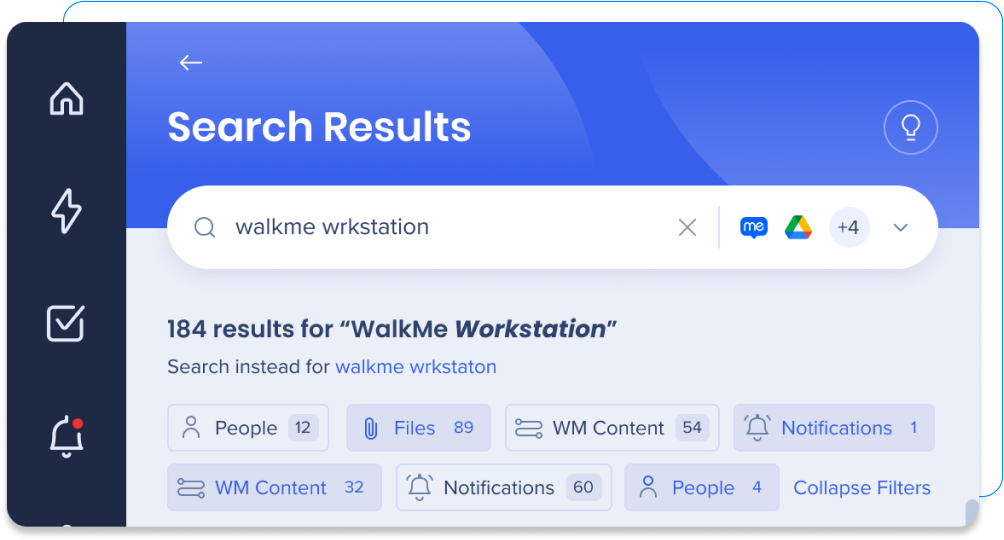
We support two options for auto-correct:
Open Library Auto-Correct
AI-Based Auto Correct
Avoid wrong search fixes
If users correct an expression for 3 times or more, it will avoid fixing it for the future. That is in order to prevent scenarios as following-
